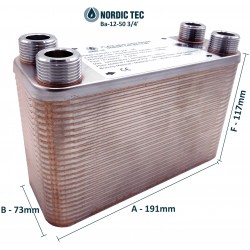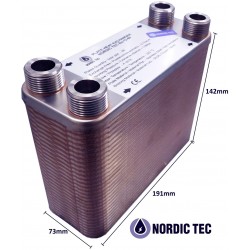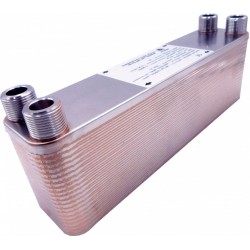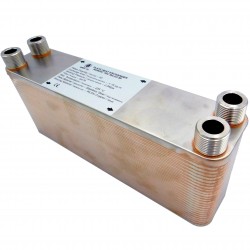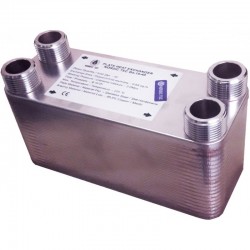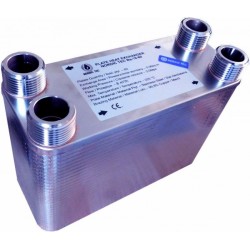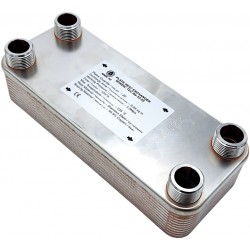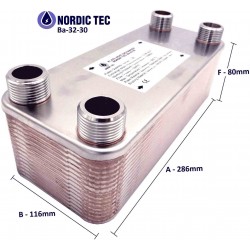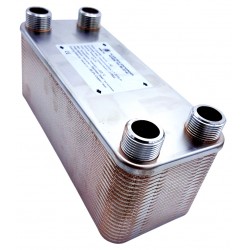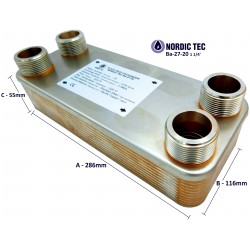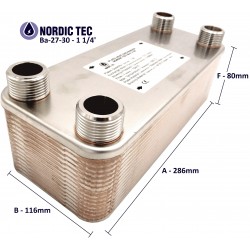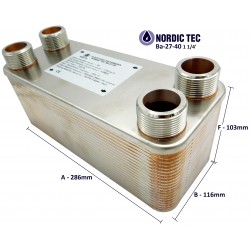Heat exchangers for District heating
District heating Heat Exchangers by Nordic Tec
In this category, you can find heat exchangers that are most commonly chosen for district heating. The models were selected based on the plate surface area that is most frequently required for connecting to the district heating network of standard-sized buildings. These models also feature the most commonly used connections: 3/4", 1", and 5/4". Each of our district heating exchangers can be purchased together with insulation and a wall bracket, which provides savings compared to purchasing these components separately.
Below the products, you will also find tips on how to choose a heat exchanger for a district heating network. If needed, remember that you can always contact our support service.
Plate Heat Exchanger NORDIC Ba-32-30 1" 175kW
Heat exchanger for urban or district heating | Nordic Tec
A heat exchanger for district heating is an important component connecting our house or apartment to the district heating system, which uses heat supplied from the heating network. Its purpose is to efficiently transfer thermal energy between the network water and the internal installation of our building, ensuring reliable heating. Plate heat exchangers are most commonly used for district heating; they are particularly popular for this application due to their compact design, high efficiency, and ease of installation. A well-chosen exchanger provides virtually maintenance-free heating comfort, as the system automatically draws the necessary amount of heat from the heating plant. Our only concern is the proper selection and correct connection of the device.
Urban heating net and a PHE - Heat Exchanger
Why are plate heat exchangers specifically the best solution for connecting a house to a district heating network? In the past, other models were also used, but over time, they were replaced by plate heat exchangers. They have several advantages in this application – primarily, the price-to-performance ratio is favorable. However, this is not their only advantage – a plate heat exchanger offers the highest heat transfer rate while maintaining small dimensions, which is very important. Currently, plate heat exchangers for district heating are a natural choice if we decide on this heating model.
Heat exchanger for district heating – selection
The selection of a heat exchanger for district heating in most cases is not difficult, as it is simply a mathematical correlation between the surface area of the exchanger plates and the surface area of the house or apartment to be connected to the city's or district's heating network.
The company Nordic Tec, which offers heat exchangers for district heating, suggests using the following coefficient for their products:
- 0.3 m² of plate surface per 100 m² of building if the building is relatively new and has proper insulation
- 0.35 m² of plate surface per 100 m² of building if the building is old or has an outdated, less efficient heating system
- Add approximately 0.2 m² to the total value if the same heat exchanger is to also heat domestic hot water
To easily synchronize the exchanger with the district network and the home heating system, attention should also be paid to the size of the connections. In new buildings, sizes of 1" or 3/4" are usually sufficient, while in old heating systems, it is often 1" or 1 ¼".
Heat exchangers for district heating – how much do they cost
In practice, it turns out that heat exchangers for district heating, based on Nordic Tec prices, are not expensive and certainly do not constitute an expense that would significantly affect the cost-effectiveness of using district networks. The prices of plate heat exchangers suitable for this application start at just €100 and rarely exceed €200.
Which model of plate heat exchanger for a district network – examples
The Nordic Tec catalog offers a range of plate heat exchangers with a surface area ranging from 0.5 to 1 m² of heat exchange surface. Such plate heat exchangers are best suited for connecting standard-sized single-family homes to district heating. These include, among others:
- Plate heat exchanger Ba-23-30, with a surface area of 0.69 m² and ¾” connections
- Plate heat exchanger Ba-16-32, with a surface area of 0.51 m² and 1” connection
- Plate heat exchanger Ba-32-20, with a surface area of 0.64 m² and 1” connection
- Plate heat exchanger Ba-16-50, with a surface area of 0.8 m² and 1” connection
- Exchanger with a slightly larger connection, ideal for older systems – Ba-27-30, with a surface area of 0.81 m² and 1 ¼” connection
Where to buy a heat exchanger for a district heating network?
Nordic Tec heat exchangers for district heating networks are best purchased directly from the manufacturer's store, i.e., nordictec-shop.eu. This way, you get access to manufacturer prices and can also buy exchangers together with accessories, such as thermal insulation to reduce heat loss or a mounting bracket for installing the device on the wall.
Can a heat exchanger for district heating work with underfloor heating?
Yes, a heat exchanger for district heating can work with both underfloor heating and radiators. From the perspective of this device, the type of heating system is not crucial; the essential factor is simply heat reception from the exchanger. District heating is also perfectly suited for low-temperature heating systems such as underfloor heating, which by nature is efficient and economical.
